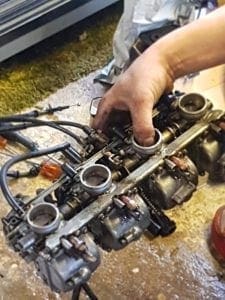At MoreBikes, we’re always looking for something new and different to get our teeth stuck into. And while poring over videos of small Japanese men tearing through a pre-set course of multi-coloured cones on motorcycles twice their size, we couldn’t believe the level of skills and close quarters control on display. It caused our jaws to drop – and we knew we had to give Moto Gymkhana a go.
WHAT’S MOTO GYMKHANA?
If you’ve not heard of it before, MotoGymkhana is a high energy, technical motorcycle sport that doesn’t take itself too seriously. It’s all about skill – requiring accurate control, bursts of speed and ruthless braking to navigate a pre-designed course in the shortest amount of time, with the least amount of errors.
All that you need to take part is a willingness to improve and learn, along with your licence and a road legal motorcycle – and from there you’ll be able to improve your throttle control, steering and braking, and push your skills in ways you probably never thought possible on a motorcycle. And best of all, it’s an open displacement competition – which means you can take part on any machine you like, providing it’s road legal – and is all about a rider’s ability, rather than about how much (or little) horsepower a particular bike kicks out. Sounds cool, right?
AND HOW DOES IT WORK?
On the day you’ll rock up – grab a coffee, say hello, meet the organisers, sign on, grab a numbered bib and listen to the riders briefing. From there you’ll be given a course map, and will be partnered up with another experienced rider or a course marshal, who will be on hand to assist you and help you learn the course.
When your number is called, you’ll head across to a short warm up course (typically a figure of eight) to get you ready for your run. You’ll then be called to the start box by the marshal, and told “When you’re ready, in your own time”. Then it’s over to you – you’ll get two attacks to set your best time around the pre-set course, hopefully without any penalties (from touching a pylon, missing a jink line or dabbing your foot down). As soon as your front wheel breaks the beam the clock is ticking, and it won’t stop until you make it back to the finish box. Simple. Well, in theory at least – providing you can remember which way the course goes and what the coloured cones mean.
WHAT HAVE WE BEEN UP TO?
So, now you know what Moto Gymkhana is and how it works, we’re going to be delving deeper into the specifics of the sport. We’ve spent some time with Andrew Freeman, boss man at the Moto Gymkhana Association – who’s been showing us the ropes; explaining what the different coloured pylons (cones) mean, how a competition course works, teaching us a few moves, and trying to get us ready for our first competition.
TALKING TECHNIQUE
If you’ve seen any Moto Gymkhana before, you’ll see some big lean angles on display. And while being able to bank the bike over at low speed is a key part of Gymkhana, it’s more important that you’re up to speed with your throttle control, clutch control and braking, using both front and rear.
MOTO GYMKHANA TOP TIPS
Keep Control. Lock your legs onto the bike and squeeze the tank with your legs.
Don’t tense up. Relax your arms, keep your elbows in and make sure your movements are smooth.
Positioning is key. Sit forward on the seat, and as you turn tilt your torso from your hips- as your body weight and position will make a massive difference at low speed
Use your head. Turn and look into the turn – the bike will follow.
Don’t be afraid of the rear brake. It’ll help you bring your turns in tighter.
The bike wants to turn – so let it. Once you’ve tipped in, the bike will follow the arc of the turn, don’t fight it, just use throttle and brake to keep it under control.
COMPLETING THE COURSE
Moto Gymkhana courses are created using a number of set pieces. There are slaloms, figure-of-eights, full rotations, 180-degree turns and jinks which are linked together to create a full course. Simple, right?
What’s not simple is working out which way to go around them. Admittedly, the colour of the cone does let you know from which direction you need to pass. If it’s red, you pass on the right, if it’s blue, you pass on the left. But, some sections can be completed in any number of ways, so it’s imperative that you learn the course in detail at the start of the day – because if you get it wrong, and fail to correct yourself, you won’t post a time.
THE HISTORY OF MOTO GYMKHANA
Moto Gymkhana combines ‘Moto’ – shorthand for motorbike, with ‘Gymkhana’ an event consisting of speed pattern racing and timed games for riders, traditionally on horseback. In fact, its origin can be linked to the term ‘O-Mok-See’, which is thought to have originated from the Native American Blackfeet tribe, who used it to describe a particular style of riding horses.
Admittedly, MotoGymkhana is a relatively new phenomenon in the UK and Europe, but it first started in Japan over 40 years ago, with motorcyclists with limited budgets getting together to enjoy informal and fun competitions between themselves on non-dedicated racetracks – before dealers and manufacturers caught on to the idea, and began holding competitions to advertise and promote their products. But since then, it’s done a full circle and moved from manufacturer/dealer led, back to rider led events open to any make of motorcycle.
OUR BIKE
We’ve got our hands on a budget Bandit 600S for less than a grand. At the minute, we’ve left it as standard, but we’re looking to make a handful of changes to make it competition ready. Nothing too wild – but we’re planning to tweak the front forks, firm up the rear brake, shed a little weight where possible, and maybe stick some wide bars on it too.
Of course, it needed a little bit of work to get it running sweet. So our resident spanner-man Rob Bean gave the little Bandit a once over and made sure everything was in good working order ahead of our training days with Andrew.
ROB BEAN – OUR RESIDENT MECHANIC
Rob’s very handy with a set of spanners. From building bad-ass endurance racers from the ground up in his shed to fettling fuel systems and cleaning carbs – if you’re based in Lincolnshire, and you’re looking for someone to sort your trivial two-wheeled problems, Rob’s your man.
WHAT’S TO COME?
So, now you know what Moto Gymkhana is, how it works and have an idea of some of the techniques to employ out on the track – it’s about time for us to give it a go. Next time, we’re going to be heading to Donington Park to get stuck into some competition. Wish us luck.
FOR MORE INFORMATION, VISIT: www.motogymkhana.org










